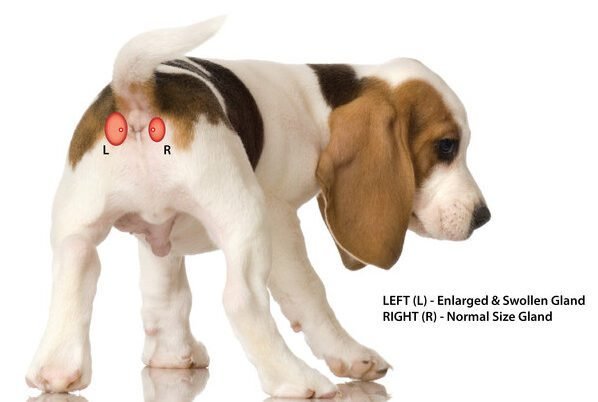A subject not for the faint hearted! Anal Gland disease is a common and distressing condition in pets and is one of the common causes of ‘scooting’ behaviour – where a dog or cat drags its bottom along the carpet,
Anal glands are two small glands located on either side of the dogs (and cats) rectal opening at roughly the 4 o’clock and 8 o’clock position. They are naturally expressed when your pet passes a motion or when they become excited or scared. Each gland has small ducts that open just inside the anus. When contracted they secrete a rather foul smelling liquid substance into the sac.
Whenever your dog urinates or defecates, the anal glands receive a small amount of pressure, and a tiny bit of the fluid is released, along with the dog’s custom blended scent. The dog can also express a little of his personal essence when he meets a fellow canine. By sniffing, the dogs learn to identify each other by their unique scents.
If the anal glands are not sufficiently expressed normally as the dog moves his bowels, the anal glands start to fill with fluid and begin to become uncomfortable for the dog. Symptoms include scooting and/or licking excessively at the anal region. Occasionally, an affected dog may become uncomfortable enough to begin acting abnormally. The dog may become irritable and even lethargic. The tail may be held at an abnormal angle or tucked under the body.
If intervention does not occur, bacteria is given the chance to build up, leading to numerous problems. The liquid within the glands may begin to thicken and eventually become a thick dark-colored material which fills the anal glands. Left untreated, anal glands can become infected, abscess and even rupture through the skin, resulting in an open wound near the rectum leading to further complications which are often difficult to cure.
The swelling and infection hurt. Attempts to pass a motion will cause alot of pain – so much that the dog may not go to the toilet as often as it should and constipation can occur.
Anal gland diseases:
Impaction – an inflammatory condition in the anal sac where the duct become blocked due to the gland not being expressed naturally during defecation. Manual expression may be the only treatment necessary and can be done externally or internally.
Sacculitis – infection in the gland often caused by bacteria. Expression and antibiotics may be required.
Abscessation – a painful swelling beside the anus which will need to be drained if it hasn’t already burst, followed by antibiotics.
Neoplasia (cancer) – older female dogs are the main group effected by anal sac tumour (adenocarcinoma). These are a malignant tumour and recurrence after removal is common.
Recurrent impaction may be due to underlying disease processes, eg skin allergy, and these may need to be investigated further. Routine expression of anal gland should be avoided as irritation and inflammation of the gland will occur.
Diet – Changing your dog’s diet can help. Many dogs with anal sac disease are ‘over-round hounds’. Obesity in dogs causes many problems and anal sac disease is just one. A low-fat/high fibre diet will help to reduce the dogs weight, as well as help with anal sac disease. The goal is to add bulk to the dogs droppings so that squeezing of the sacs during toileting is more common. Increase the fibre in the dog’s diet by adding bran or grated carrot to its meal. Higher quality dog foods that produce a firmer, more compact stool also aid the expressing of the anal glands, as do raw meaty bones.
Early Recognition – don’t wait until the anus is abscessed before seeing the Vet. If your dog is scooting or constantly licking at the area, make an appointment!

